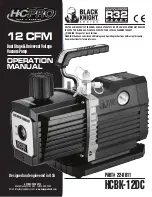
en
44
Installation and operating instructions • Wilo-DrainLift BOX • Ed.06/2022-10
•
Select installation site:
–
Inside the building.
–
Flat and firm surface (e.g., concrete, screed, etc.)
–
Not in the immediate vicinity of living and sleeping areas.
•
Observe the installation and fitting dimensions.
6.4.4.2 Installing the lifting unit (floor
mounted)
1
2
3
Fig. 14:
Lifting unit installation
1
Ground
2
Bearing surface
3
Mains connection, version without switchgear
✓
Lifting unit prepared for installation.
✓
Two persons present.
✓
Required installation material:
2x coupling sleeves for DN 100 connection ports.
1x hose section with 2x pipe clamps (included in scope of delivery).
1x anti-syphon trap for cable entry
1x fixation material for buoyancy safeguards (included in the scope of delivery)
✓
Open DN 100 connection ports.
1.
Position the lifting unit at the planned location on a flat and clean surface.
2.
Align the connection ports with the pipes.
3.
Coil the connection cables and attach them to the discharge pipe with a cable tie.
NOTICE! To allow the pumps or float switches to be lifted out of the tank as required,
a cable loop (approx. 1 m/3 ft) must remain in the chamber!
CAUTION! The connection cables must not impede the movement of the float switch!
If the float switch cannot move freely, this may cause the system to malfunction.
4.
All connection cables (for pumps and float switches) should be led outside via the vent-
ilation pipe using a drawing wire.
NOTICE! Install an anti-syphon trap at the transition in the operating space!
5.
Slide the coupling sleeves over the DN 100 connection ports to make the inlet and vent-
ilation connections.
6.
Place the hose section on the discharge connection.
7.
Push the hose clips on the discharge connection.
8.
Place the hose section on the discharge pipeline.
Fig. 15:
Assembling the buoyancy safeguards
9.
Attach hose section with hose clip on discharge connection and on the on-site dis-
charge pipe.
CAUTION! Max. tightening torque: 5 Nm (3.7 ft·lb)!
NOTICE! To prevent a backflow from the main public sewer, the discharge pipeline
must be installed as a “pipe loop”. The bottom edge of the pipe loop must be above
the locally defined backflow level (usually street level) at its highest point!
10. Mount the buoyancy safeguards on the hose section and attach to surface with suitable
dowels.
11. Perform a leak test in accordance with the applicable regulations.
12. Position the O-ring in the neck of the tank.
13. Put the cover (cover plug) in the neck of the tank and close the lifting unit.
▶
The lifting unit is now installed properly.
Summary of Contents for DrainLift BOX
Page 2: ...DrainLift BOX https qr wilo com 742...
Page 3: ...3 Chinese 4 English 26...
Page 5: ...zh CHS Wilo DrainLift BOX Ed 06 2022 10 5 1 1 1 1 2 WILO SE 2022 1 3 Wilo 1 4 Wilo 2 2 1...
Page 6: ...zh CHS 6 Wilo DrainLift BOX Ed 06 2022 10 1 2 2...
Page 8: ...zh CHS 8 Wilo DrainLift BOX Ed 06 2022 10 2 7 2 8 2 9 3 3 1 DIN EN 12050 EN 12050 2...
Page 51: ......









































